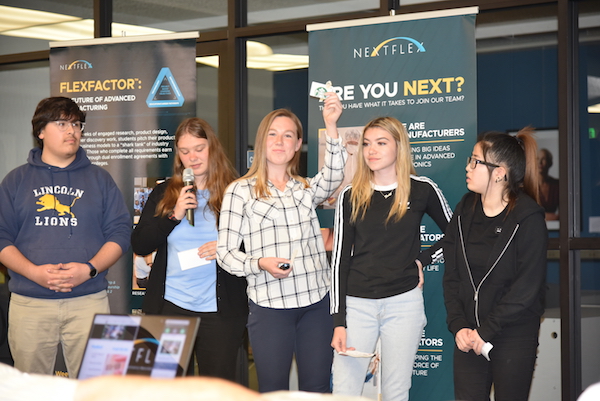
The FlexFactor program gives students the opportunity to see how advanced materials and products can combine to create innovative solutions to a diverse range of problems. Image courtesy of FlexFactor.
Latest News
January 22, 2020
FlexFactor’s Final Pitch Event is a one-day competition held at the end of FlexFactor’s 4-week technology and entrepreneurship program. This multi-week program challenges students to work in teams to identify a real-world problem, conceptualize an advanced hardware solution and build a business model around it that they present at the final pitch event.
Brynt Parmeter is the director of workforce development, education and training at NextFlex. We spoke to Parmeter to learn more about their competition.
Digital Engineering: Can you provide an overview of your competition, how it came to be and its intent? Who will be participating or who has participated? How many participants have you had or do you expect? Are there demographics of participants?
Brynt Parmeter: The program was started in the Silicon Valley in 2016 and within only two years, the program has expanded from eight students to over 3,500 students in three geographic regions: California, Ohio and Alabama. The core intent of this program is to inform, attract and recruit young people from unengaged to engaged talent and motivate them to pursue education and career pathways in technology and advanced manufacturing.
FlexFactor inspires middle school, high school and higher education students from all over the country to go into fields of work they might not have known of without completing the program while also encouraging female and minority student involvement in tech and advanced manufacturing.
DE: Can you tell us about some of the designs that are part of the event and how they came to be?
Parmeter: The FlexFactor program gives students the opportunity to see how advanced materials and products can combine to create innovative solutions to a diverse range of problems. It also helps kickstart their advanced manufacturing career paths by familiarizing them with the technology and the vast range of professional opportunities in the field.
Throughout the program, students gain hands-on experience applying cutting-edge flexible electronics to real-world problems, and acquiring industry exposure to further explore their career paths by visiting advanced manufacturing facilities operated by companies such as Jabil and DuPont in Silicon Valley, or Blue Spark and TRG in Ohio, and by seeing how advanced technologies are being used today and what it’s like to work in the technical fields.
At the end of the program, teams pitch their product ideas “shark tank style” with guidance from industry mentors and educators. After completion of the program, students receive further information from participating colleges regarding pursuing STEM related majors for future careers in technology and advanced manufacturing.
DE: Can you provide some examples of what the event has produced or what you expect it to produce?
Parmeter: Last month, NextFlex co-hosted FlexFactor Final Pitch Event: Silicon Valley, in partnership with Evergreen Valley College. During the finals, top student teams from across Silicon Valley delivered a hardware device “pitch” on their stated problem area, their solution for that problem and a business model to a panel of industry experts.
At the end of the final pitches, the students who completed the four weeks of FlexFactor became empowered architects of their futures, and knowledgeable about the education pathways that will lead them there.
DE: Does your organization, or the consortium of organizers of this competition, have a particular stance on adopting an innovation that is linked to the program? What drives firms to sponsor the event and coordinate it?
Parmeter: At the core of the FlexFactor program is flexible hybrid electronics (FHE). NextFlex focuses on FHE technology because … conceptually speaking, it is a fairly easy technology to understand both in how it is created and how it will change the world around us. It provides an excellent “innovation vehicle” for student teams looking to explore how advanced technologies will be able to address the most series challenges of the future.
DE: Is there anything else you’d like to tell us about the event that the above questions haven’t given you the opportunity to express?
Parmeter: The FlexFactor program taps into the potential in youth whose circumstances sometimes have isolated them from the experiences, networks, pathways and opportunities that so frequently determine future economic success and social mobility.
Through FlexFactor, the talent pipeline is diversified as students who previously hadn’t considered higher education or STEM-based careers muster the courage to realize their potential.
Subscribe to our FREE magazine, FREE email newsletters or both!
Latest News
About the Author
Jim Romeo is a freelance writer based in Chesapeake, VA. Send e-mail about this article to DE-Editors@digitaleng.news.
Follow DE





